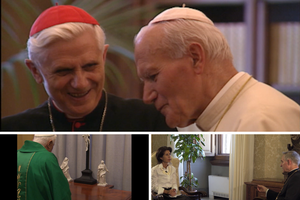Take a Marian Journey Through the Eternal City
BOOK PICK: Rome: A Pilgrimage With Mary

ROME: A PILGRIMAGE WITH MARY
By Father Joseph Roesch, MIC
Marian Press, 2018
160 pages, $24.95
To order: shopmercy.org or (800) 462-7426
Who better to go on a pilgrimage with than our Blessed Mother? Readers can take an “armchair pilgrimage” via Rome: A Pilgrimage With Mary, “stopping” at several churches dedicated to the Mother of God or honoring her in special ways, primarily through magnificent artwork.
Tour guide Marian Father Joseph Roesch highlights the sacred places that have been honoring the Mother of God since Christianity first came to the Eternal City.
This coffee-table-sized book is filled with many eye-catching photos of the various portrayals of Mary, from iconography to paintings to statues in their church settings. Father Roesch is an able guide, having been a resident of this city since 2005, working in the administration of the Congregation of Marian Fathers.
He brings readers first to St. Peter’s Basilica and the mosaic Mater Ecclesiae (Mother of the Church) that St. John Paul II had installed overlooking the square. The pictorial tour continues to the Pietà, with the accompanying photos showing the famed statue’s exquisite details.
The next stop is the Basilica di Santa Maria Magggiore (St. Mary Major), home of the renowned image of Mary in her title of Salus Populi Romani (Salvation of the People of Rome), which is thought to have been painted by St. Luke. There’s another surprise for readers here — a magnificent photo of Our Lady, Queen of Peace, commissioned by Benedict XV in thanksgiving for the end of World War I. Another “plus” to ponder is the basilica’s majestic mural of the Assumption.
Father Roesch’s brief descriptions introduce readers to the churches and highlight the Marian images, telling of their particular significance. But he lets the images speak for themselves. As the photographs show, in church after church, glorious murals honor Mary, filling walls or ceilings, surrounded by gorgeous ornamental architecture.
Santa Maria del Rosario a Monte Maria (Our Lady of the Rosary) has an icon titled Mother of God that is thought to have been drawn by St. Luke and later painted miraculously. The book’s images of this icon allow readers to look into the motherly eyes of Mary. Another icon attributed to St. Luke is among many images of Mary in Sant’Augostino (Basilica of St. Augustine). The 16th-century sculpture of Our Lady of Safe Delivery is a favorite prayerful destination for expectant mothers in Rome.
At Santa Maria in Via (Our Lady on the Way), Father Roesch highlights the miraculous image of Our Lady of the Well, placed by Pope Alexander IV. Marian veneration dates to 1256, the year that Pope Alexander canonically approved the practice. “To this day, many healings through the intercession of Our Lady are reported, both through prayer before the image as well as by means of water from the well,” Father Roesch explains.
“… The image of Our Lady, from the 13th century, is simple but striking. The story of the well is amazing.”
Sant’Andrea delle Fratte, St. Andrew of the Thickets, has a miraculous side altar where the Blessed Mother appeared to agnostic, anti-Catholic Alphonse Ratisbonne, who immediately converted and became a Catholic priest. Father Roesch has concelebrated Mass at this altar of the “Madonna of the Miracle.” St. Maximilian Kolbe celebrated a Mass of thanksgiving at this altar after his ordination, too. Other pilgrimage stops include San Pantaleo (Church of St. Pantaleon and of St. Joseph Calasanz), known and visited by St. Stanislaus Papczynski, who founded the Congregation of Marian Fathers of the Immaculate Conception of the Most Blessed Virgin Mary.
Bonus pages visit small “corner” Marian shrines on Roman buildings, about 500 in number, to show Mary is venerated practically everywhere in Rome. Overall, this book’s full-color pilgrimage inspires. What better guide than Mary to help lead the pilgrim Church on earth — and through Rome?
Joseph Pronechen is a
Register staff writer.
- Keywords:
- joseph pronechen
- marian art
- rome

















